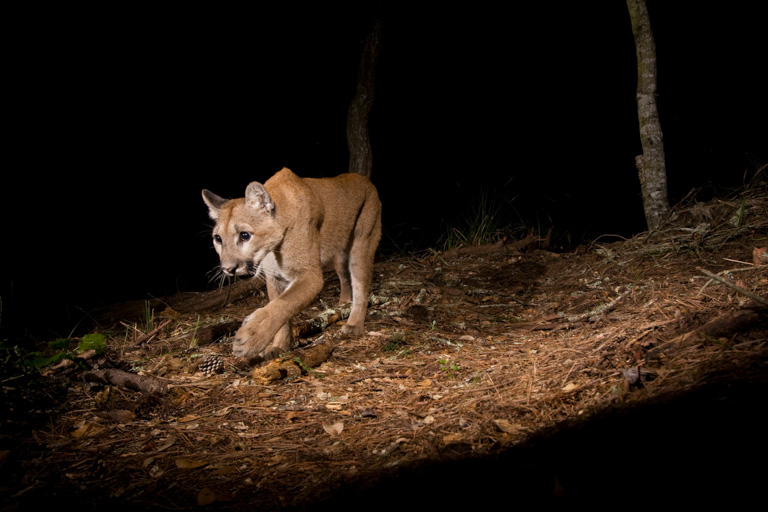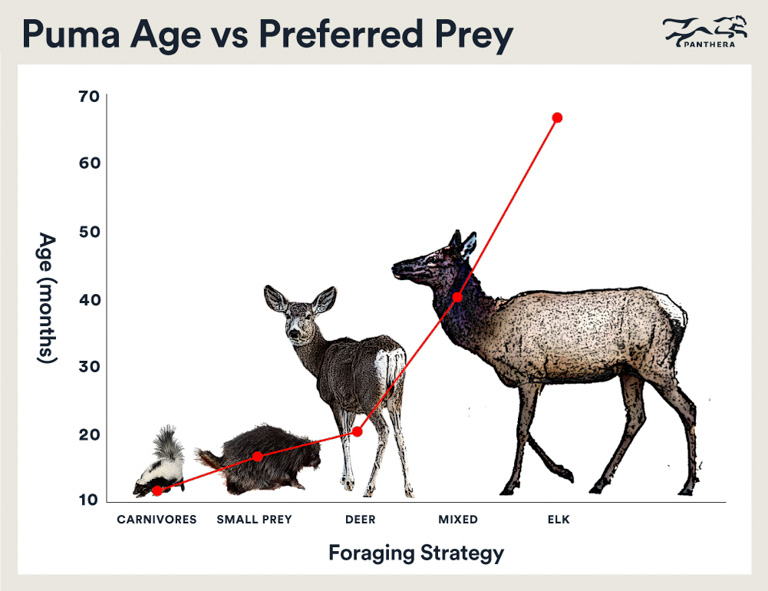- A new study finds that the age of individual pumas near Jackson, Wyoming, had the greatest influence over the prey they chose to hunt.
- Older mountain lions went after elk, among the largest prey species in the study area, while the younger cats hunted small animals like raccoons as well as mule deer.
- The research calls into question the validity of recent wildlife management plans in the western United States to grow mule deer populations by culling mountain lions, the authors say.
The puma family took biologist Mark Elbroch by surprise. They were supposed to be a ways off. But here they were, year-old kittens, bungling the final moments of a baby mule deer’s life in a matted-down circle of grass as the mother mountain lion looked on.
Elbroch, the puma program director for Panthera, saw a rare opportunity to capture on film what biologists call “operant learning.” So he set up the remote cameras he had in his backpack, and he waded back into the hip-high grass of western Wyoming and out of sight.
What unfolded on film over the next 25 minutes confirmed that “mountain lions take a long time to become efficient killers,” Elbroch said. Even at a year old and each outweighing the fawn by 50 pounds (23 kilograms) or more, he said, “They’re just clueless.”
They still hadn’t dispatched the screaming fawn when the kittens dragged it off camera. “It’s horrific to watch,” Elbroch said.

It turns out that, as pumas learn to hunt throughout their lifetimes — even long after they’ve left their mothers’ sides — it affects their choice of prey.
This discovery, reported March 29 in the journal Conservation Science and Practice, potentially calls into question the assumption that allowing hunters to kill more pumas (Puma concolor) will translate into more of the elk (Cervus elaphus nelsoni) and mule deer (Odocoileus hemionus) that human hunters prize. This assumption has led to recent decisions to increase hunting of mountain lions in the western United States.
Elbroch and his Panthera colleague, Howard Quigley, pulled together data on 13 GPS-collared pumas between April 2012 and January 2016 from the organization’s long-term Teton Cougar Project based near Jackson, Wyoming. They then modeled the data to gauge the influence of different factors, such as age, elevation and the animal’s sex, along with various combinations of these variables, on the prey these individual animals went after. The results of the analysis, Elbroch said, were “incredibly simple.”
“As pumas get older, they tend to select larger prey,” he said. And the reason for that is equally straightforward.

“It takes time to learn how to take down monstrous animals that are eight times your size,” Elbroch said. Mountain lions “risk their lives every time they jump on the back of something big.”
Young cougars typically go after small prey like hares, raccoons and grouse. With age, they graduate to killing mule deer and then to specializing on elk, the most common preference among the cats in the study and the one favored by the oldest animals.
Those results suggest that recent moves to increase the numbers of sought-after trophy species of herbivores like mule deer might be ill-advised and counterproductive. Colorado Parks and Wildlife, the state’s game agency, has embraced a “predator control” strategy involving the hunting and trapping of up to 15 pumas and 25 black bears (Ursus americanus) a year with the goal of boosting a flagging mule deer population in the state’s northwest corner. The deer’s meat and the males’ antlers make it a favorite quarry of hunters, and Panthera said pressure from hunting groups helped set this plan in motion.
But earlier research in Idaho demonstrated that taking pumas (and coyotes) out of the equation didn’t help local mule deer populations grow, even though more females and fawns survived. Another study revealed a correlation between sustained puma hunting and a younger puma population, as hunters seek out and kill the oldest and largest cats. The upshot of that finding, taken together with this new study, is that killing more pumas might actually increase the proportion of the population that specializes in mule deer, which are smaller and easier to bring down than elk, Elbroch said.

“The conclusion that unintended consequences are possible is a really important one,” Kyle Knopff, a wildlife biologist with Golder Associates in Calgary, Alberta, said in an interview.
Knopff, who was not involved in this study, noted that 13 animals was a small sample size that made it difficult to draw more specific conclusions, and agreed with Elbroch’s view that the results warranted further testing with more mountain lions over longer time periods. Knopff also noted the “incredible amount of effort” that such research would entail.
In 2010, Knopff, then at the University of Alberta, and his colleagues published a study in The Journal of Wildlife Management that examined the prey selection of more than 50 pumas in Alberta. Among their most significant findings was the notion that individual puma prey preferences varied, with male pumas, which are much bigger than females, going after large game like moose (Alces alces).
But, Knopff added, more research is needed to confidently say that puma hunting will or will not increase populations of ungulates, the hoofed mammals that include elk, deer and bighorn sheep.
“In some systems that may be true,” he said. “In others, it’s clearly not.”

“In my view, the actual scientific conclusion is that we need to be very careful how and under which circumstances we harvest predators if our intentions around predator management are to have some certain outcome for ungulate populations,” Knopff said.
“The take-home message here is that it does matter what animals you remove from the population,” John Laundré, a cougar biologist at Western Oregon University, said in an interview.
Laundré said Elbroch’s study supported what researchers have been saying about predator-prey relationships for decades.
“It’s not the predator that determines how many prey there are,” Laundré said. “It’s the weather, how much food, how cold it gets, how hot it gets, all these types of things.”
Indeed, many scientists blame protracted droughts across the western U.S., not pumas or other predators, for diminished mule deer numbers.

Still, reining in predator populations remains a favored wildlife management strategy at agencies across the West. Elbroch said it was important to note that the legal hunting in its current form across the western United States and Canada won’t wipe out pumas, Elbroch said. Wildlife managers “have done a super job of maintaining mountain lions on the landscape.”
But, he said, “I do believe that hunting is the greatest threat to the stability and the ecological function of mountain lions.”
In a recent study, Elbroch and his team made the case that mountain lions are “ecosystem engineers” because the carcasses they leave behind provide food and habitat for a wide range of other creatures. The researchers found 215 species of beetles in prey animals killed by mountain lions.
While current management strategies ensure that cougars persist in the West, these approaches don’t account for the “unintentional effects” of hunting, Elbroch said. In his view, that calls for a “move away from the numerical assessment” of mountain lions.
“Numbers are not what build populations. Individuals build populations,” Elbroch said. “Mountain lions are individuals. We need to recognize that.”
Banner image of a puma by Mark Elbroch/Panthera.
John Cannon is a Mongabay staff writer based in the Middle East. Find him on Twitter: @johnccannon
Citations
Barry, J. M., Elbroch, L. M., Aiello-Lammens, M. E., Sarno, R. J., Seelye, L., Kusler, A., … & Grigione, M. M. (2018). Pumas as ecosystem engineers: ungulate carcasses support beetle assemblages in the Greater Yellowstone Ecosystem. Oecologia, 1-10. doi:10.1007/s00442-018-4315-z
Elbroch, L. M., & Quigley, H. (2019). Age‐specific foraging strategies among pumas, and its implications for aiding ungulate populations through carnivore control. Conservation Science and Practice, 1(4), e23. doi:10.1111/csp2.23
Hurley, M. A., Unsworth, J. W., Zager, P., Hebblewhite, M., Garton, E. O., Montgomery, D. M., … & Maycock, C. L. (2011). Demographic response of mule deer to experimental reduction of coyotes and mountain lions in southeastern Idaho: Réponse Démographique du Cerf Mulet à la Réduction Expérimentale des Populations de Coyotes et de Pumas dans le Sud de l’Idaho. Wildlife Monographs, 178(1), 1-33. doi:10.1002/wmon.4
Knopff, K. H., Knopff, A. A., Kortello, A., & Boyce, M. S. (2010). Cougar kill rate and prey composition in a multiprey system. The Journal of Wildlife Management, 74(7), 1435-1447. doi:10.2193/2009-314
Teichman, K. J., Cristescu, B., & Darimont, C. T. (2016). Hunting as a management tool? Cougar-human conflict is positively related to trophy hunting. BMC Ecology, 16(1), 44. doi:10.1186/s12898-016-0098-4
FEEDBACK: Use this form to send a message to the author of this post. If you want to post a public comment, you can do that at the bottom of the page.
